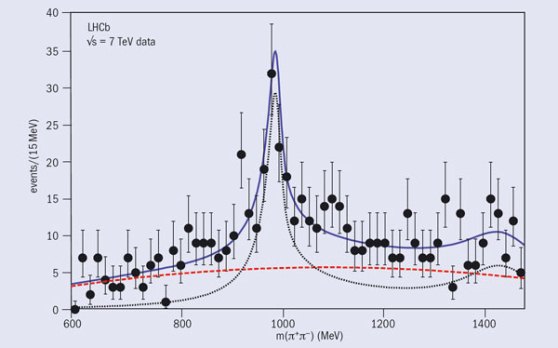Using data collected in proton–proton collisions at the LHC at a centre-of-mass energy of 7 TeV, the LHCb experiment has observed two new rare decay modes of B0s mesons for the first time. The decay B0s → J/ψ f0(980) will be important for studying differences between properties of matter and anti-matter (CP violation for experts) in the B0s system, while the decay B0s → D*–s2Xμ+ν will be valuable for testing predictions of strong interaction (QCD) theory.
The first new decay mode observed is of the decay B0s → J/ψ f0(980). The B0s consists of a b antiquark (b) bound with an s quark, and can decay to a J/ψ (cc) together with an ss state, which can be a φ or, more rarely, an f0. While the φ decays to K+K–, the f0 decays to π+π–. The figure shows the enhancement in the π+π– invariant mass distribution in the region of 980 MeV indicating an observation of f0(980).

click in the image to get it in higher resolution
The observation of these two new decay modes demonstrates that the LHCb experiment is already competitive in the field of heavy flavour physics. Great progress is expected with the larger data sample due from the coming run, with the potential to constrain, or even observe, new physics.
Read more details in the CERN Courier article, which also includes description of the second decay.
Read more details in the National Science Foundation article.
